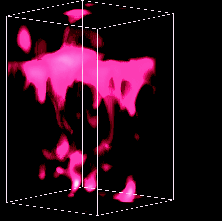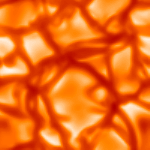Convection
 Convective motion, or convection for short, resembles
the motions that arise in boiling water, where the energy of the hot plate
is transported up to the surface of the water by hot water
rising from the bottom and cold water sinking from the top.
Near the surface of stars much the same happens, apart from the fact
that the motion is really driven by the cooling of gas at the surface,
which causes cold gas to plummet down. The net effect is the same
however : energy is transported to the surface.
In the film shown on the right you can see how the cold gas, shown in pink,
moves down from the surface, which is the horizontal plane in the box.
"Cold" in this connection means about 1000 K cooler than the surroundings,
and the surroundings have a temperature of about 4000 K near the top of the
box, 5777 K at the surface and 21000 K at the bottom of the box.
Convective motion, or convection for short, resembles
the motions that arise in boiling water, where the energy of the hot plate
is transported up to the surface of the water by hot water
rising from the bottom and cold water sinking from the top.
Near the surface of stars much the same happens, apart from the fact
that the motion is really driven by the cooling of gas at the surface,
which causes cold gas to plummet down. The net effect is the same
however : energy is transported to the surface.
In the film shown on the right you can see how the cold gas, shown in pink,
moves down from the surface, which is the horizontal plane in the box.
"Cold" in this connection means about 1000 K cooler than the surroundings,
and the surroundings have a temperature of about 4000 K near the top of the
box, 5777 K at the surface and 21000 K at the bottom of the box.
 In order to understand convection it is necessary to construct
3-dimensional computer models, called simulations.
The images and the film on this page are examples of such simulations.
The film to the left shows a cross-section of the outer
parts of a star, and the surface is seen as the transition between
black and red, at the top of the image. The colours show the temperature,
with black being the coldest and white the hottest.
You can see clearly how tongues of cool gas (dark) plunge down,
after which they more or less dissolve and disappear.
In order to understand convection it is necessary to construct
3-dimensional computer models, called simulations.
The images and the film on this page are examples of such simulations.
The film to the left shows a cross-section of the outer
parts of a star, and the surface is seen as the transition between
black and red, at the top of the image. The colours show the temperature,
with black being the coldest and white the hottest.
You can see clearly how tongues of cool gas (dark) plunge down,
after which they more or less dissolve and disappear.
 A close look at the surface of the Sun shows light areas, called granules,
which consist of warm gas that is rising up to the surface.
The picture shows the corresponding results from the simulations.
At the surface the gas cools
down and sinks at the sides of the granules, which can be seen as the dark
traces in between the granules. This pattern is called granulation
on the solar surface.
The film shows how big granules are split in the middle and some of
the small granules are squeezed between some bigger ones until they disappear.
This film, which is made using a computer simulation, is very similar to
a film of the surface of the real Sun.
A close look at the surface of the Sun shows light areas, called granules,
which consist of warm gas that is rising up to the surface.
The picture shows the corresponding results from the simulations.
At the surface the gas cools
down and sinks at the sides of the granules, which can be seen as the dark
traces in between the granules. This pattern is called granulation
on the solar surface.
The film shows how big granules are split in the middle and some of
the small granules are squeezed between some bigger ones until they disappear.
This film, which is made using a computer simulation, is very similar to
a film of the surface of the real Sun.
It is the convection which excites the oscillations we observe
in the Sun. This corresponds to the noises made by a kettle or pan
when boiling water. In order to understand why the oscillations
are there, we therefore need to understand how convection produces sound.
This happens particularly effectively near the solar surface, where gas
moves with speeds that are close to the speed of sound. Turbulent (that
is to say disordered) gas motions with speeds close to the speed of
sound generate sound waves very effectively : this is shown, for example,
by the noise from jet-engines. The sound waves, produced near the solar
surface then propagate into the solar interior
and produce the standing waves that we see as the oscillations on the
solar surface.
In the Sun the convective zone extends over the outer 28 %
of the solar radius. Its extent was measured precisely by analysing
observations of solar oscillations.
We believe that the interaction
between convective gas motions and the rotation somehow
causes the variation in the rotation rate of the Sun that we
observe on the surface and also
in the interior.
 In order to understand convection it is necessary to construct
3-dimensional computer models, called simulations.
The images and the film on this page are examples of such simulations.
The film to the left shows a cross-section of the outer
parts of a star, and the surface is seen as the transition between
black and red, at the top of the image. The colours show the temperature,
with black being the coldest and white the hottest.
You can see clearly how tongues of cool gas (dark) plunge down,
after which they more or less dissolve and disappear.
In order to understand convection it is necessary to construct
3-dimensional computer models, called simulations.
The images and the film on this page are examples of such simulations.
The film to the left shows a cross-section of the outer
parts of a star, and the surface is seen as the transition between
black and red, at the top of the image. The colours show the temperature,
with black being the coldest and white the hottest.
You can see clearly how tongues of cool gas (dark) plunge down,
after which they more or less dissolve and disappear.
 Convective motion, or convection for short, resembles
the motions that arise in boiling water, where the energy of the hot plate
is transported up to the surface of the water by hot water
rising from the bottom and cold water sinking from the top.
Near the surface of stars much the same happens, apart from the fact
that the motion is really driven by the cooling of gas at the surface,
which causes cold gas to plummet down. The net effect is the same
however : energy is transported to the surface.
In the film shown on the right you can see how the cold gas, shown in pink,
moves down from the surface, which is the horizontal plane in the box.
"Cold" in this connection means about 1000 K cooler than the surroundings,
and the surroundings have a temperature of about 4000 K near the top of the
box, 5777 K at the surface and 21000 K at the bottom of the box.
Convective motion, or convection for short, resembles
the motions that arise in boiling water, where the energy of the hot plate
is transported up to the surface of the water by hot water
rising from the bottom and cold water sinking from the top.
Near the surface of stars much the same happens, apart from the fact
that the motion is really driven by the cooling of gas at the surface,
which causes cold gas to plummet down. The net effect is the same
however : energy is transported to the surface.
In the film shown on the right you can see how the cold gas, shown in pink,
moves down from the surface, which is the horizontal plane in the box.
"Cold" in this connection means about 1000 K cooler than the surroundings,
and the surroundings have a temperature of about 4000 K near the top of the
box, 5777 K at the surface and 21000 K at the bottom of the box.
